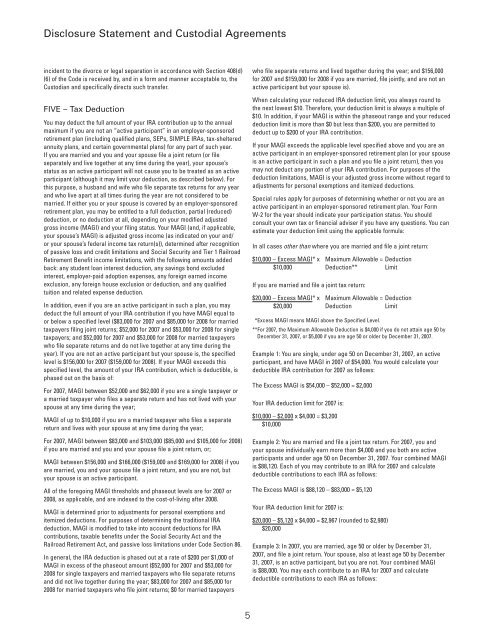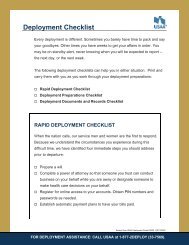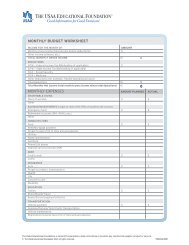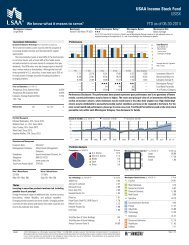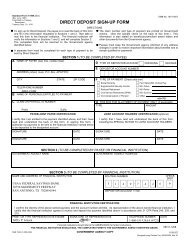Traditional and Roth IRA CD Application - USAA
Traditional and Roth IRA CD Application - USAA
Traditional and Roth IRA CD Application - USAA
Create successful ePaper yourself
Turn your PDF publications into a flip-book with our unique Google optimized e-Paper software.
Disclosure Statement <strong>and</strong> Custodial Agreementsincident to the divorce or legal separation in accordance with Section 408(d)(6) of the Code is received by, <strong>and</strong> in a form <strong>and</strong> manner acceptable to, theCustodian <strong>and</strong> specifically directs such transfer.FIVE – Tax DeductionYou may deduct the full amount of your <strong>IRA</strong> contribution up to the annualmaximum if you are not an “active participant” in an employer-sponsoredretirement plan (including qualified plans, SEPs, SIMPLE <strong>IRA</strong>s, tax-shelteredannuity plans, <strong>and</strong> certain governmental plans) for any part of such year.If you are married <strong>and</strong> you <strong>and</strong> your spouse file a joint return (or fileseparately <strong>and</strong> live together at any time during the year), your spouse’sstatus as an active participant will not cause you to be treated as an activeparticipant (although it may limit your deduction, as described below). Forthis purpose, a husb<strong>and</strong> <strong>and</strong> wife who file separate tax returns for any year<strong>and</strong> who live apart at all times during the year are not considered to bemarried. If either you or your spouse is covered by an employer-sponsoredretirement plan, you may be entitled to a full deduction, partial (reduced)deduction, or no deduction at all, depending on your modified adjustedgross income (MAGI) <strong>and</strong> your filing status. Your MAGI (<strong>and</strong>, if applicable,your spouse’s MAGI) is adjusted gross income (as indicated on your <strong>and</strong>/or your spouse’s federal income tax return(s)), determined after recognitionof passive loss <strong>and</strong> credit limitations <strong>and</strong> Social Security <strong>and</strong> Tier 1 RailroadRetirement Benefit income limitations, with the following amounts addedback: any student loan interest deduction, any savings bond excludedinterest, employer-paid adoption expenses, any foreign earned incomeexclusion, any foreign house exclusion or deduction, <strong>and</strong> any qualifiedtuition <strong>and</strong> related expense deduction.In addition, even if you are an active participant in such a plan, you maydeduct the full amount of your <strong>IRA</strong> contribution if you have MAGI equal toor below a specified level ($83,000 for 2007 <strong>and</strong> $85,000 for 2008 for marriedtaxpayers filing joint returns; $52,000 for 2007 <strong>and</strong> $53,000 for 2008 for singletaxpayers; <strong>and</strong> $52,000 for 2007 <strong>and</strong> $53,000 for 2008 for married taxpayerswho file separate returns <strong>and</strong> do not live together at any time during theyear). If you are not an active participant but your spouse is, the specifiedlevel is $156,000 for 2007 ($159,000 for 2008). If your MAGI exceeds thisspecified level, the amount of your <strong>IRA</strong> contribution, which is deductible, isphased out on the basis of:For 2007, MAGI between $52,000 <strong>and</strong> $62,000 if you are a single taxpayer ora married taxpayer who files a separate return <strong>and</strong> has not lived with yourspouse at any time during the year;MAGI of up to $10,000 if you are a married taxpayer who files a separatereturn <strong>and</strong> lives with your spouse at any time during the year;For 2007, MAGI between $83,000 <strong>and</strong> $103,000 ($85,000 <strong>and</strong> $105,000 for 2008)if you are married <strong>and</strong> you <strong>and</strong> your spouse file a joint return, or;MAGI between $156,000 <strong>and</strong> $166,000 ($159,000 <strong>and</strong> $169,000 for 2008) if youare married, you <strong>and</strong> your spouse file a joint return, <strong>and</strong> you are not, butyour spouse is an active participant.All of the foregoing MAGI thresholds <strong>and</strong> phaseout levels are for 2007 or2008, as applicable, <strong>and</strong> are indexed to the cost-of-living after 2008.MAGI is determined prior to adjustments for personal exemptions <strong>and</strong>itemized deductions. For purposes of determining the traditional <strong>IRA</strong>deduction, MAGI is modified to take into account deductions for <strong>IRA</strong>contributions, taxable benefits under the Social Security Act <strong>and</strong> theRailroad Retirement Act, <strong>and</strong> passive loss limitations under Code Section 86.In general, the <strong>IRA</strong> deduction is phased out at a rate of $200 per $1,000 ofMAGI in excess of the phaseout amount ($52,000 for 2007 <strong>and</strong> $53,000 for2008 for single taxpayers <strong>and</strong> married taxpayers who file separate returns<strong>and</strong> did not live together during the year; $83,000 for 2007 <strong>and</strong> $85,000 for2008 for married taxpayers who file joint returns; $0 for married taxpayerswho file separate returns <strong>and</strong> lived together during the year; <strong>and</strong> $156,000for 2007 <strong>and</strong> $159,000 for 2008 if you are married, file jointly, <strong>and</strong> are not anactive participant but your spouse is).When calculating your reduced <strong>IRA</strong> deduction limit, you always round tothe next lowest $10. Therefore, your deduction limit is always a multiple of$10. In addition, if your MAGI is within the phaseout range <strong>and</strong> your reduceddeduction limit is more than $0 but less than $200, you are permitted todeduct up to $200 of your <strong>IRA</strong> contribution.If your MAGI exceeds the applicable level specified above <strong>and</strong> you are anactive participant in an employer-sponsored retirement plan (or your spouseis an active participant in such a plan <strong>and</strong> you file a joint return), then youmay not deduct any portion of your <strong>IRA</strong> contribution. For purposes of thededuction limitations, MAGI is your adjusted gross income without regard toadjustments for personal exemptions <strong>and</strong> itemized deductions.Special rules apply for purposes of determining whether or not you are anactive participant in an employer-sponsored retirement plan. Your FormW-2 for the year should indicate your participation status. You shouldconsult your own tax or financial adviser if you have any questions. You canestimate your deduction limit using the applicable formula:In all cases other than where you are married <strong>and</strong> file a joint return:$10,000 – Excess MAGI* x Maximum Allowable = Deduction$10,000 Deduction** LimitIf you are married <strong>and</strong> file a joint tax return:$20,000 – Excess MAGI* x Maximum Allowable = Deduction$20,000 Deduction Limit*Excess MAGI means MAGI above the Specified Level.**For 2007, the Maximum Allowable Deduction is $4,000 if you do not attain age 50 byDecember 31, 2007, or $5,000 if you are age 50 or older by December 31, 2007.Example 1: You are single, under age 50 on December 31, 2007, an activeparticipant, <strong>and</strong> have MAGI in 2007 of $54,000. You would calculate yourdeductible <strong>IRA</strong> contribution for 2007 as follows:The Excess MAGI is $54,000 – $52,000 = $2,000Your <strong>IRA</strong> deduction limit for 2007 is:$10,000 – $2,000 x $4,000 = $3,200$10,000Example 2: You are married <strong>and</strong> file a joint tax return. For 2007, you <strong>and</strong>your spouse individually earn more than $4,000 <strong>and</strong> you both are activeparticipants <strong>and</strong> under age 50 on December 31, 2007. Your combined MAGIis $88,120. Each of you may contribute to an <strong>IRA</strong> for 2007 <strong>and</strong> calculatedeductible contributions to each <strong>IRA</strong> as follows:The Excess MAGI is $88,120 – $83,000 = $5,120Your <strong>IRA</strong> deduction limit for 2007 is:$20,000 – $5,120 x $4,000 = $2,967 (rounded to $2,980)$20,000Example 3: In 2007, you are married, age 50 or older by December 31,2007, <strong>and</strong> file a joint return. Your spouse, also at least age 50 by December31, 2007, is an active participant, but you are not. Your combined MAGIis $88,000. You may each contribute to an <strong>IRA</strong> for 2007 <strong>and</strong> calculatedeductible contributions to each <strong>IRA</strong> as follows:5


